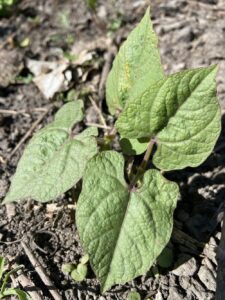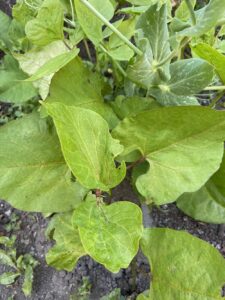Creeping through the garden in her pyjamas, Alys Fowler plants a magical crop.

Before breakfast I like to plant dwarf beans. I tiptoe through the garden in my slippers and bedclothes, popping beans into every conceivable spot. A handful every few days.
Over the years I’ve come to love dwarf beans because they demand no scaffolding or climbing frame, and their short stature means they live fast. This means you can keep sowing right up to around the first week in July. This final sowing is for fresh green beans only, and sometimes needs a little hand because they won’t crop till September — if the nights are cold and the beans not quite big enough, it’s worth cloching or covering with some sort of fleece. Certainly, if you are sowing to harvest whole beans to dry for winter stores, you need to get on with it; your last sowing should be no later than next week. Sow two beans at a time directly into the soil, with roughly 20cm between them. You might want to put some pea sticks in around the edges for more vigorous varieties, and this will also keep those with very long beans from sitting on the soil — an invitation for slugs to have their fill. But other than that, it’s as easy as poking a hole in the soil and dropping a bean in.
All beans are magical, because they do lead to better land. Thanks to a wild relationship with bacteria, they feed the soil they grow in. They house these bacteria in odd warty nodules on their roots. And in return for a sweet, summer-long supply of sugars and other good things, the bacteria capture nitrogen from the atmosphere and whip it into a form that the bean can use. Truly magic to capture nitrogen from the air and turn it into fertiliser.

Once the bean plants die, the root nodules fall off in the soil and break down, where the bacteria then lie dormant till the next bean comes along. This is the reason you don’t dig up your bean or pea plants at the end of their life, but leave the roots intact to rot back. Any excess nitrogen will also be picked up by the next crop that grows in the space, so it’s always worth sowing a green manure around the base of your beans toward the end of August, beginning of September to sup up the spares.
Nitrogen dissolves readily, so is easily leached out the soil, unless you give it something green and growing to suck it up. Nothing quite sups up nitrogen better than Italian grazing rye, which grows deep green all winter long. When rye is suppressed in spring as it dies off, the nitrogen is returned to the soil ready for the next crop. I like to think of this nitrogen, with all its vibrant green, caught in the growth then being passed to the soil, then back to a new plant. It pleases me greatly to think of it bouncing along like a beat in the passing of time.
This method with grazing rye works particularly well in pots, that look quite handsome with their fringe of green grass all winter long. It means you only have to top up the pots with a few inches of compost in spring, rather than renewing the whole lot, which saves a fortune.
I meant to write something much more poetical about beans: about how it feels to put your hand into a pocket of smooth, cool beans and pluck one or two out to sow, of the crack of a dried pod at harvesting, of that sweet flavour of a sun-warmed raw runner bean, till you eat too many and become queasy — but it turns out I only really have practical things to say about the art of bean growing, so that is what you are getting.
